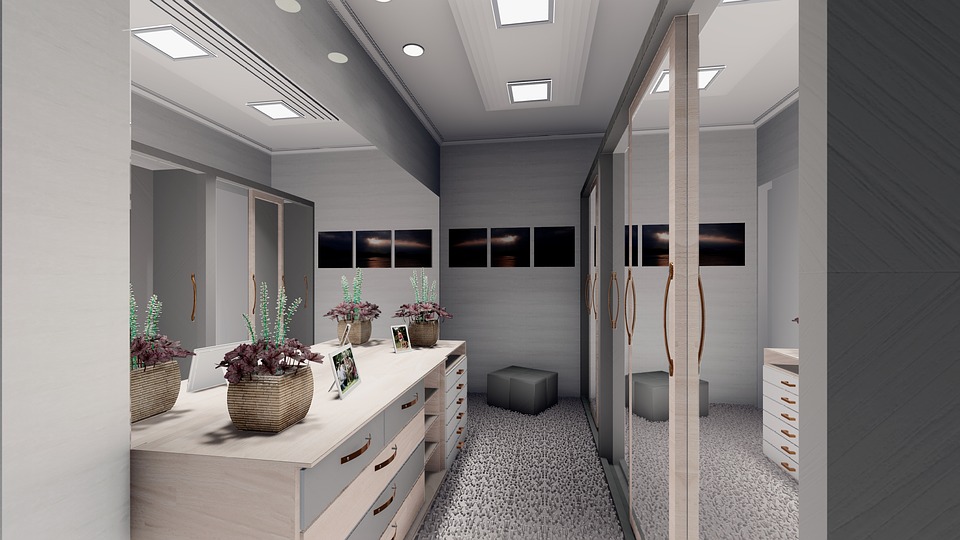Contents
– What type of dressing room to choose?
– How to store a dressing room?
– What other alternative to open or closed dressing room?
– How much does a dressing room cost, and where can I find one?
Having a dressing room, a well-designed place dedicated to the storage of clothes and accessories, but also to that of shoes, is now within everyone’s reach. When the time comes to choose, the question arises: open or closed dressing room? What is the best formula? With this post, you’ll discover the advantages and disadvantages of open or closed dressing rooms to help you make your choice.

Which type of dressing room should I choose?
Both options have their advantages and disadvantages, which you should consider to avoid regretting your choice.
Opened dressing room
Clothes and shoes are visible; the choice is quick. It is best reserved for a room dedicated to this purpose, part of a master suite, for example. It can be small, like a wide hallway, but must have a passage of at least 70 cm so that access to shelves and rods remains comfortable. It can also be a larger place, with a layout on two or three walls, and sometimes even a central island to store belts and jewelry, or a seat to dress and put on shoes more easily.
But the open dressing room does not have to be a separate space. You can also choose an open layout in a room, on a long wall where you will install furniture from floor to ceiling, equipped with shelves, closed boxes, drawers, and rods. This arrangement is easy to live with but requires a certain sense of order and is reserved for meticulous people.
A piece of beginning equipment will be in white melamine, but you can opt for more luxurious elements in veneer or solid wood, in species more or less rare. Storage options can also significantly impact the cost of the fittings, such as glass spaces for storing jewelry or drawers with compartments for pairs of socks or watches, for example.
Closed dressing room
This can also be a dedicated room closed by a classic or sliding door, and which leaves nothing to be seen from the outside, whose equipment will be similar to that of an open dressing room.

But most often, it is a closet-dressing, closed with curtains or sliding or folding doors, whose interior is optimized and equipped with rods, drawers, and shelves. Its primary quality is its cost, which is adjustable depending on the materials used and the size, smaller than that of an open dressing room; its easy living side is an additional asset because a closed dressing room can hide anything that is not very aesthetic or even very well stored.
The closing systems are diverse, ranging from the simple eyelet curtain, sliding on a round bar installed on the top of the ceiling, or by Japanese panels, to sliding doors, from the basic two-panel white melamine door to multi-panel sliding doors made of lacquered glass, leather, or mirror, equipped with brakes and anti-dust systems. The interior equipment can also vary in terms of quality, as for the open dressing room, and be simply white, or more elaborate in veneer, and more rarely in solid wood.
There are also systems of folding doors, less used today than in the 70s, but which have the advantage of folding on the sides to let see the entire interior of the dressing room. They come in many finishes, but the most common are wood or metal to keep certain ease of handling.
Good to know: whether you choose an open or closed dressing room, a single hanger model is essential to keep the aesthetics of this space.
How to set up a dressing room?
Whether it is open or closed, a dressing room is arranged logically: on top hats and other headgear, in the middle sweaters and T-shirts, jackets and blazers, and at the bottom pants. A high rod will accommodate long clothes, dresses, and coats. At the bottom are the shoes. The drawers will hold lingerie, classified by type and socks and tights.
What other alternative to the open or closed dressing room?
The open dressing room is most often a dedicated space, and the closed dressing room is a section of wall closed by a system of doors. There are on the market modular dressing rooms from 1 meter wide and 60 cm deep, designed with integrated storage, sometimes double rods at the top and bottom, and which are ideal if you are a tenant and still want to own a dressing room. They come in many finishes, and their doors can be equipped with mirrors.
How much does a dressing room cost, and where can I find one?
There are many commercial proposals for an open or closed dressing room, and they can be found in large DIY stores, kit furniture stores, classic furniture stores, and also at closet and dressing room design specialists, at very different prices, depending on the type of equipment and the quality of the materials:
– Fitting an open dressing room, post, and shelves in white melamine from $120 per linear meter.
– Dressing room kit to be installed in a closet with sliding doors from $90 in 180 cm wide and 203 cm high.
– Sliding closet doors in white melamine from $90 in 205 cm wide and 250 cm high.
– Wardrobe from $400 in dimension 200 cm wide and 230 cm high.
We hope this article has helped you choose which type of dressing room is right for you. Don’t forget to leave us your comments below.


